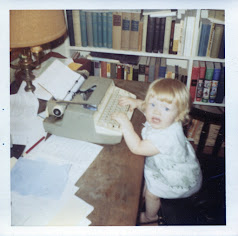An Amanuensis is a person employed to write what another dictates or to copy what has been written by another. Amanuensis Monday is a daily blogging theme which encourages the family historian to transcribe family letters, journals, audiotapes, and other historical artifacts. Not only do the documents contain genealogical information, the words breathe life into kin – some we never met – others we see a time in their life before we knew them.
Howard Matthews was my paternal grandfather and although I don't remember hearing about it while he was alive, it seems he also had the genealogy bug. In the last years of his life he was trying to put together a family history with as much information as he could find. Although an accomplished accountant, he was a frustrating family historian because he didn't cite his sources. Still, he left behind a some wonderful details that I hope will help me on my own genealogical journey.
Over the coming weeks I will be sharing my grandfather's typewritten history (put together in 1984) in order to preserve it for posterity, put it out there for other family members and hopefully give you some entertainment along the way.
The first installment will give you some family background, a little history of Pittston, PA and introduce you to my great-grandfather.
A Story
by Howard B Matthews
I, Howard Bierly Matthews, was born in our family home, 13 Nafus Street, Pittston, Pennsylvania, on July 1, 1901, the 8th child of my father, Arthur William Matthews, the sixth of him and his second wife, Ada Hobbs Matthews. I am the survivor of these eight children, 2 daughters and six sons. My mother was 46 and my father 57 when I was born.
 |
| 13 Nafus Street, Pittston, PA Date Unknown |
Pittston was one of the five townships founded by loyalists from Connecticut in 1768. It is named after William Pitt, first Earl of Chatham, a graduate of Cambridge and a member of Parliament. It is situated in Luzerne County in northeastern Pennsylvania, on the main branch of the Susquehanna River, in historic Wyoming Valley, scene of the contest between Connecticut and Pennsylvania over land ownership which each claimed to have obtained from the Six Indian Nations in 1754 and 1762. The dispute resulted in warfare between early settlers who espoused Pennsylvania’s claim and the Crown Loyalists who upheld Connecticut’s. The Crown was unable to settle the argument, warfare continued and eventually resulted in victory for the Crown forces who had the assistance of Tory Rangers and Iriquois [sic] Indians. There followed in 1778 the Wyoming Massacre, one of the bloodiest in American history.
Anthracite coal became the largest source of employment and wealth in that part of Pennsylvania. Records indicate that the first shipment of coal was made in 1807 via the Susquehanna river and that coal was shipped directly from Pittston as early as 1813. By 1850, a series of double-tracked planes had been constructed to haul coal from Pittston over the mountains to Hawley, Pennsylvania, where a canal provided a connection to the Delaware and the Hudson rivers. Later, the Delaware, Lackawanna and Western Railroad became the thoroughfare for the shipment of coal to the west.
In 1851 a plank road was built connecting Wilkes-Barre and Pittston and, via a bridge across the Susquehanna, to West Pittston. The first National Bank of Pittston was established in 1864 (my nephew, Willard Hunter was later to become its President). There followed the Miners Bank in 1869 and the Peoples Bank in 1871. Pittston’s newspaper, the Gazette, was established in 1850. There were three churches: the Methodist, established in 1808, the Presbyterian in 1842 and the Episcopal in 1848. By 1865 Pittston was a community of about five thousand homes.
The foregoing is by way of a setting for the arrival of my father. He joined aforesaid Methodist Church on February 28, 1869.
My father was born in Coleford, Monmouthshire, England, the seventh child of Mark and Mary Matthews who also were born in Coleford. He spoke Welsh, that unpronounceable language. As a young man he had worked in and around the coal mines in Coleford. He came to the USA as a member of a British orchestra which arrived in New York City the day Lincoln was buried*. I think he must have been about 23 at that time. He left the orchestra, settled in Pittston and never again saw his native land.
*Abraham Lincoln was buried in Springfield, IL on May 4, 1865. I searched New York passenger lists for that date and did not find any Arthur Matthews arriving in NYC that day. I did find an Arthur Matthews arriving in New York from Liverpool on April 25, 1865 - the second day that Lincoln's procession was in the city.
*Abraham Lincoln was buried in Springfield, IL on May 4, 1865. I searched New York passenger lists for that date and did not find any Arthur Matthews arriving in NYC that day. I did find an Arthur Matthews arriving in New York from Liverpool on April 25, 1865 - the second day that Lincoln's procession was in the city.




Great document, it's nice to have descriptions of people from those that really knew them ("he spoke Welsh") and a great head start on your family history. I have a similar document, although written about my 2nd great-grandfather, not by him (which would have been amazing!) by an equally frustrating family historian that cited no sources. Oh well, hopefully we leave our descendants in better shape!
ReplyDelete